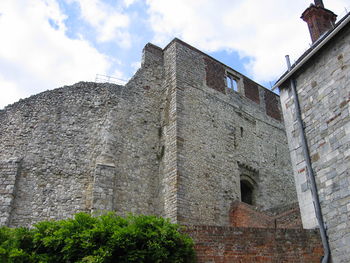Farnham Castle: Difference between revisions
Jump to navigation
Jump to search

imported>Richard Nevell No edit summary |
imported>Richard Nevell (Add illustration) |
||
| Line 1: | Line 1: | ||
{{subpages}} | {{subpages}} | ||
'''Farnham Castle''' in [[Surrey]] was founded in the 12th century by [[Henry de Blois]], the Bishop of Winchester. The castle was built on a ridge of chalk at the northern end of the town of Farnham. The town originated as a [[Saxon]] settlement, but was greatly expanded in the 12th century, around the time Bishop Henry built the castle. Farnham Castle was originally a motte an bailey, with a square stone tower standing on top of an earthen mound (the motte), surrounded by an enclosure (the bailey) containing ancillary buildings. The tower which now stands was a 12th-century replacement of the previous tower which was destroyed by Henry II in 1155.<ref>Robertson, Jane (2000). ''Extensive Urban Survey of Surrey: Farnham''. Woking: Surrey County Archaeological Unit. pp. 5, 8–9.</ref> | {{Image|Farnham Castle keep, 2004.jpg|right|350px|The ruins of Farnham Castle's great tower}} | ||
'''Farnham Castle''' in [[Surrey]] was founded in the 12th century by [[Henry de Blois]], the Bishop of Winchester. The castle was built on a ridge of chalk at the northern end of the town of Farnham. The town originated as a [[Saxon]] settlement, but was greatly expanded in the 12th century, around the time Bishop Henry built the castle. Farnham Castle was originally a motte an bailey, with a square stone great tower standing on top of an earthen mound (the motte), surrounded by an enclosure (the bailey) containing ancillary buildings. The tower which now stands was a 12th-century replacement of the previous tower which was destroyed by Henry II in 1155.<ref>Robertson, Jane (2000). ''Extensive Urban Survey of Surrey: Farnham''. Woking: Surrey County Archaeological Unit. pp. 5, 8–9.</ref> | |||
Farnham Castle is both a Grade I [[listed building]] and a [[scheduled monument]].<ref>"[http://www.heritagegateway.org.uk/Gateway/Results_Single.aspx?uid=247314&resourceID=2 Farnham Castle]", ''Pastscape''. Accessed 10 March 2013.</ref><ref>"[http://www.heritagegateway.org.uk/Gateway/Results_Single.aspx?uid=1044677&resourceID=5 Farnham Castle (comprising castle buildings to the south only)]", ''The National Heritage List for England ''. Accessed 10 March 2013.</ref> | Farnham Castle is both a Grade I [[listed building]] and a [[scheduled monument]].<ref>"[http://www.heritagegateway.org.uk/Gateway/Results_Single.aspx?uid=247314&resourceID=2 Farnham Castle]", ''Pastscape''. Accessed 10 March 2013.</ref><ref>"[http://www.heritagegateway.org.uk/Gateway/Results_Single.aspx?uid=1044677&resourceID=5 Farnham Castle (comprising castle buildings to the south only)]", ''The National Heritage List for England ''. Accessed 10 March 2013.</ref> | ||
Revision as of 10:14, 10 March 2013
Farnham Castle in Surrey was founded in the 12th century by Henry de Blois, the Bishop of Winchester. The castle was built on a ridge of chalk at the northern end of the town of Farnham. The town originated as a Saxon settlement, but was greatly expanded in the 12th century, around the time Bishop Henry built the castle. Farnham Castle was originally a motte an bailey, with a square stone great tower standing on top of an earthen mound (the motte), surrounded by an enclosure (the bailey) containing ancillary buildings. The tower which now stands was a 12th-century replacement of the previous tower which was destroyed by Henry II in 1155.[1]
Farnham Castle is both a Grade I listed building and a scheduled monument.[2][3]
References
- ↑ Robertson, Jane (2000). Extensive Urban Survey of Surrey: Farnham. Woking: Surrey County Archaeological Unit. pp. 5, 8–9.
- ↑ "Farnham Castle", Pastscape. Accessed 10 March 2013.
- ↑ "Farnham Castle (comprising castle buildings to the south only)", The National Heritage List for England . Accessed 10 March 2013.
